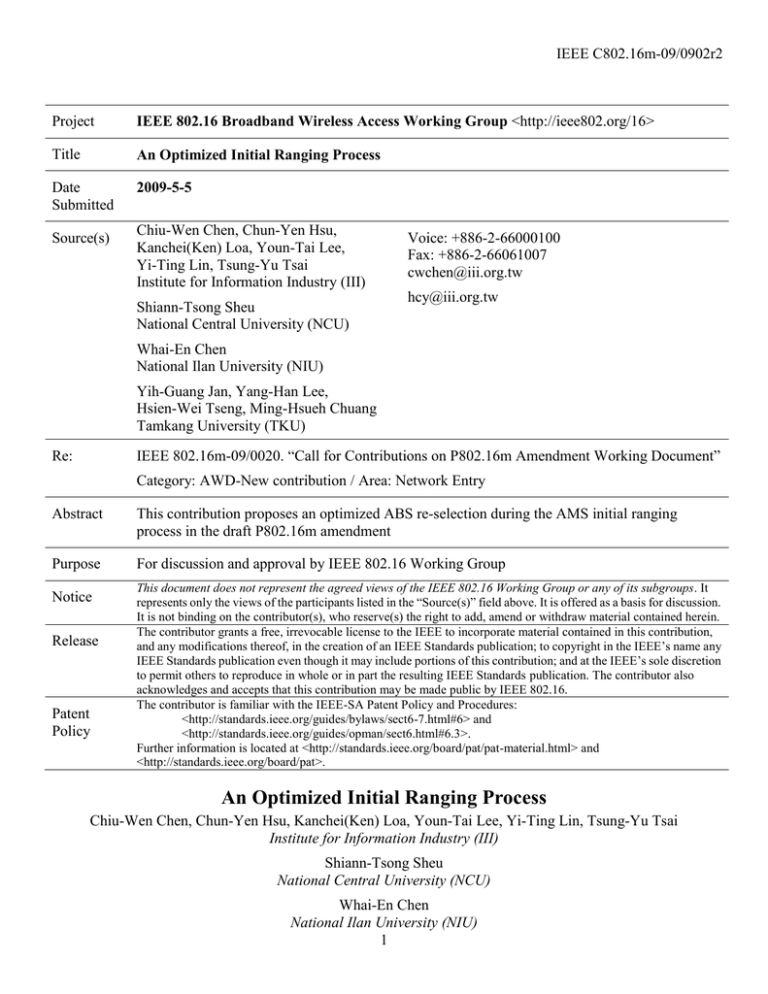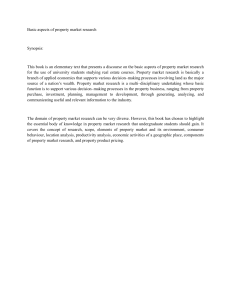IEEE C802.16m-09/0902r2 Project Title
advertisement

IEEE C802.16m-09/0902r2
Project
IEEE 802.16 Broadband Wireless Access Working Group <http://ieee802.org/16>
Title
An Optimized Initial Ranging Process
Date
Submitted
2009-5-5
Source(s)
Chiu-Wen Chen, Chun-Yen Hsu,
Kanchei(Ken) Loa, Youn-Tai Lee,
Yi-Ting Lin, Tsung-Yu Tsai
Institute for Information Industry (III)
Shiann-Tsong Sheu
National Central University (NCU)
Voice: +886-2-66000100
Fax: +886-2-66061007
cwchen@iii.org.tw
hcy@iii.org.tw
Whai-En Chen
National Ilan University (NIU)
Yih-Guang Jan, Yang-Han Lee,
Hsien-Wei Tseng, Ming-Hsueh Chuang
Tamkang University (TKU)
Re:
IEEE 802.16m-09/0020. “Call for Contributions on P802.16m Amendment Working Document”
Category: AWD-New contribution / Area: Network Entry
Abstract
This contribution proposes an optimized ABS re-selection during the AMS initial ranging
process in the draft P802.16m amendment
Purpose
For discussion and approval by IEEE 802.16 Working Group
Notice
Release
Patent
Policy
This document does not represent the agreed views of the IEEE 802.16 Working Group or any of its subgroups. It
represents only the views of the participants listed in the “Source(s)” field above. It is offered as a basis for discussion.
It is not binding on the contributor(s), who reserve(s) the right to add, amend or withdraw material contained herein.
The contributor grants a free, irrevocable license to the IEEE to incorporate material contained in this contribution,
and any modifications thereof, in the creation of an IEEE Standards publication; to copyright in the IEEE’s name any
IEEE Standards publication even though it may include portions of this contribution; and at the IEEE’s sole discretion
to permit others to reproduce in whole or in part the resulting IEEE Standards publication. The contributor also
acknowledges and accepts that this contribution may be made public by IEEE 802.16.
The contributor is familiar with the IEEE-SA Patent Policy and Procedures:
<http://standards.ieee.org/guides/bylaws/sect6-7.html#6> and
<http://standards.ieee.org/guides/opman/sect6.html#6.3>.
Further information is located at <http://standards.ieee.org/board/pat/pat-material.html> and
<http://standards.ieee.org/board/pat>.
An Optimized Initial Ranging Process
Chiu-Wen Chen, Chun-Yen Hsu, Kanchei(Ken) Loa, Youn-Tai Lee, Yi-Ting Lin, Tsung-Yu Tsai
Institute for Information Industry (III)
Shiann-Tsong Sheu
National Central University (NCU)
Whai-En Chen
National Ilan University (NIU)
1
IEEE C802.16m-09/0902r2
Yih-Guang Jan, Yang-Han Lee, Hsien-Wei Tseng, Ming-Hsueh Chuang
Tamkang University (TKU)
Introduction
When an AMS powers on, it will synchronize with an ABS via A-Preamble and will obtain necessary
information for network entry. The AMS normally selects the ABS with the best signal quality to perform initial
network entry procedure. After scanning for ABSs and performing cell selection, an AMS starts the initial
ranging process with the selected ABS in order to join the network. An efficient ranging process could facilitate
the AMS performing network entry. In 16e standard, the MS shall re-scan and re-transmit the ranging code if it
is notified the abort status via RNG-RSP message from the BS. This procedure may increase access latency.
In current SDD, the ABS could respond to the AMS’s initial ranging preamble code transmission by
broadcasting a status indication message in a following predefined DL frame/subframe. We design a RNG-IND
A-MAP IE to indicate the decoding results of the initial ranging preamble code and also indicate the bandwidth
allocation to a user in order to reduce overhead and decrease access latency. Otherwise, the AAI-RNG-RSP
message shall be linked to the corresponding bit of the RNG-IND A-MAP IE to optimized parameter
adjustment and ABS re-selection. If ID privacy is not enabled, initial ranging process is over after receiving
AAI_RNG-RSP message, which includes a valid STID. If ID privacy is enabled, initial ranging process is over
after receiving AAI_RNG-RSP message, which includes a valid Temporary STID.
Figure 1 provides an example of the initial ranging process, three different cases that an AMS may
encountered during initial ranging were depicted. In this contribution, we propose the amendment text of the
optimized initial ranging process.
ABS 1
AMS
Scanning
Duration
A-Preamble/SFH
A-Preamble/SFH
Initial ranging preamble code
Case 1:
IR code is
undecoded
because of
collision
Case 2:
IR code is decoded
successfally and
adjustment para. is
success
RNG-IND
(Decoding Status =0)
Initial ranging preamble code
(Re-contend)
RNG-IND
(Decoding Status =1)
AAI-RNG-RSP
(Continue, adjust para.)
Initial ranging preamble code
RNG-IND
(Resource Allocation)
AAI-RNG-REQ
AAI-RNG-RSP
Case 3:
IR code is decoded
successfally and
adjustment para. is
failure
RNG-IND
(Decoding Status =1)
AAI-RNG-RSP
(Continue, adjust para.)
Initial ranging preamble code
RNG-IND
(Decoding Status =1)
AAI-RNG-RSP
(Abort, Preamble index override)
Initial ranging preamble code
2
ABS 2
IEEE C802.16m-09/0902r2
Figure 1
An example of the initial ranging process
Text proposal for inclusion in the 802.16m amendment:
----------------------------------------------------Start of the Text--------------------------------------------------------[Insert the following text in Section 15.2.x:]
15.2.x AMS network entry
The network entry procedure follows the procedure defined in the Section 6.3.9 unless otherwise specified in
this section.
In order to reduce overhead and decrease access latency, the ABS could respond to the AMS’s initial
ranging preamble code transmission via RNG-IND A-MAP IE in a following predefined DL frame/subframe.
And if the corresponding bit of the decoding status bitmap is set to 1, the bandwidth allocation to a user is
indicated. The following parameters shall be included in the RNG-IND A-MAP IE when the AMS is
performing initial network entry. The content of the RNG-IND A-MAP IE is shown in Table xxx.
Table xxx
RNG-IND A-MAP IE
Syntax
Size in bits
Description/Notes
RNG-IND A-MAP IE(){
─
─
A-MAP IE Type
4
Used to distinguish
between other A-MAP
IEs.
Decoding Status Bitmap
TBD
If the bit value is set to1,
this indicates the IR code
has been successfully
decoded.
If (Decoding Status Bitmap[i]=1){
─
─
variable
Used to indicate the
number of allocation
ranging preamble code
in the corresponding bit
of decoding Status
bitmap.
─
─
Ranging Code Information
TBD
Used to indicate the
ranging preamble code
attribute that was sent by
the AMS.
Resource Allocation
variable
Determines the start,
length and number of
subframes spanned the
N_Allocation_Ranging Code
For(j=0; j<N_Allocation_Ranging Code;
j++){
3
IEEE C802.16m-09/0902r2
allocation.
}
Padding
─
─
variable
Padding to bytes
boundary; padding value
shall be set to zero.
}
Decoding Status Bitmap
If the bit value is set to 1, this indicates the IR code has been successfully decoded.
N_Allocation_Ranging Code
This parameter is used to indicate the number of allocation ranging preamble code in the corresponding
bit of decoding Status bitmap.
Ranging Code Information
This parameter indicates the ranging preamble code attribute that was sent by the AMS.
Resource Allocation
Determines the start, length and number of subframes spanned the allocation.
The format of the AAI-RNG-RSP message is shown in Table yyy.
Table yyy AAI-RNG-RSP message format
Syntax
Size (bit)
Notes
AAI-RNG-RSP_Message_Format(){
─
─
Management Message Type = TBD
8
─
Reserved
8
Shall be set to zero.
TLV Encoded Information
variable
TLV-specific
─
─
}
To optimize the parameter adjustment and ABS re-selection during the AMS initial ranging process, the
following TLV parameters shall be included in the AAI-RNG-RSP message. The proposed TLV in Table zzz
are specific to the AAI-RNG-REQ message.
Name
Table zzz
AAI-RNG-RSP message encodings
Type
Length
Value
(variable length)
Ranging Status
TBD
1
Used to indicate whether UL
messages are received within
acceptable limits by ABS.
4
IEEE C802.16m-09/0902r2
1 = continue, 2 = abort.
Ranging Code Attributes
TBD
4
Used to indicate the OFDMA time
symbol reference, subchannel
reference, frame number used to
transmit the ranging preamble code,
and ranging preamble code index
that was sent by the AMS.
Adjustment Indicator
TBD
1
Used to indicate which information
should be adjusted by AMS.
1 = Timing Adjust, 2= Power Level
Adjust, 3 = Offset Frequency Adjust.
Timing Adjust
TBD
4
Tx timing offset adjustment. If this
TLV is used, the Ranging Status
value shall be set to 1.
Power Level Adjust
TBD
1
Tx power offset adjustment. If this
TLV is used, the Ranging Status
value shall be set to 1.
Offset Frequency Adjust
TBD
4
Tx frequency offset adjustment. If
this TLV is used, the Ranging Status
value shall be set to 1.
Downlink Frequency
Override
TBD
4
When the parameter is used with
A-Preamble Index Override, the MS
should redo ranging on the new DL
channel identified by the Preamble
Indices.
A-Preamble Index
Override
Number
of
Preamble
Index * 8
Preamble Indices
of the
recommended
ABS(s) where the
AMS should redo
ranging.
Preamble Indices of the
recommended ABS(s) where the
AMS should redo ranging. If this
TLV is used, the Ranging Status
value shall be set to 2. This TLV
shall be used for licensed bands only.
Ranging Status
This parameter indicates whether UL messages are received within acceptable limits by the ABS.
1 = continue, 2 = abort.
Ranging Code Attributes
This parameter indicates the OFDMA time symbol reference, subchannel reference, frame number used
to transmit the ranging preamble code, and ranging preamble code index that was sent by the AMS.
Adjustment Indicator
Used to indicate which information should be adjusted by AMS.
1 = Timing Adjust, 2= Power Level Adjust, 3 = Offset Frequency Adjust.
5
during
Network Re
IEEE C802.16m-09/0902r2
Timing Adjust
Tx timing offset adjustment. The AMS shall advance its transmission time if the value is negative and
delay its transmission if the value is positive.
Power Level Adjust
Tx power offset adjustment. This parameter specifies the relative change in transmission power level that
AMS is to make in order that transmissions arrive at the ABS at the desired power.
Offset Frequency Adjust
Tx frequency offset adjustment. This parameter specifies the relative change in transmission frequency
that the AMS is to make in order to better match the ABS. If the value is less than half of the channel
bandwidth, this is fine-frequency adjustment within a channel. Otherwise, this is re-assignment to a
different channel. The AMS shall increase its Tx frequency if the value is positive and decrease its Tx
frequency if the value is negative.
Downlink Frequency Override
Center frequency, in kHz, of new DL channel where the SS should redo ranging. If this parameter is
used, the Ranging Status value shall be set to 2.
A-Preamble Index Override
This parameter indicates the Preamble Indices of the suggested ABS(s) where the AMS should redo
ranging. If the parameter includes two or more Preamble Indices, the first one in the list is the most
preferable and the second is the next preferable. When the parameter is used with Downlink frequency
override, the MS should redo ranging on the new DL channel identified by the Preamble Indices. If this
parameter is used, the Ranging Status value shall be set to 2.
For ABS re-selection, the AAI_RNG-RSP includes “Abort” indication, the Downlink Frequency Override
and the A-Preamble Index of the suggested ABS(s) that the AMS should redo ranging should be included in the
AAI_RNG-RSP.
If ID privacy is not enabled, initial ranging process is over after receiving AAI_RNG-RSP message, which
includes a valid STID. If ID privacy is enabled, initial ranging process is over after receiving AAI_RNG-RSP
message, which includes a valid Temporary STID.
----------------------------------------------------End of the Text---------------------------------------------------------
6


